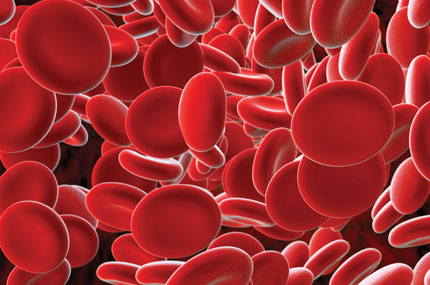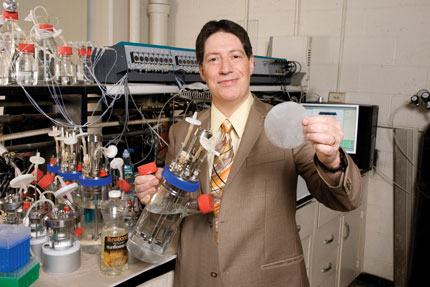Cutting-Edge Research
mathematics
Cardio Computing
Blood flow is one of the fundamental mechanisms of human life, but it remains in many ways a mystery. So little is known about the behavior of red blood cells that stents and other devices used to aid the heart and circulatory system often run the risk of inducing clots or destroying red blood cells in the process. By anticipating potential changes in red blood cells, doctors might avoid these sometimes-deadly side effects. But first they’d need something of a crystal ball.
George Biros, a former postdoctorate in computer science at the Courant Institute of Mathematical Sciences, and his research team set out to build just that. The result: blood flow simulation software that can render red blood cells traveling through plasma. The ultimate goal is to create something “like weather prediction codes, but for blood,” Biros explains.
The simulation marks an immense technological leap; the Association for Computing Machinery deemed the software about 10,000 times more advanced than its predecessors, and honored the researchers with the 2010 Gordon Bell Prize at its Supercomputing Conference last November. Biros, who is now associate professor of biomedical engineering at Georgia Institute of Technology, started the initial research for the program in 2000, while working with NYU computer scientist Denis Zorin and then-doctoral student Lexing Ying (CIMS ’00, ’04). Ten years and many algorithms later, the team grew to include members from the Oak Ridge National Laboratory—which ran the simulation on its Jaguar supercomputer—as well as NYU research scientist Shravan Veerapaneni.
And their work is not yet done. One major innovation of the program is its ability to anticipate the changing shapes, or deformation, of red blood cells, a shift previously unrendered by researchers. As the simulations continue to reveal this morphing, Biros and his colleagues will investigate the potential indications of this discovery and how it might be applied to medicine.
—Elisabeth Brown
neuroscience
The Fragile X Factor

In 10 years, alleviating some of the symptoms of Fragile X Syndrome (FXS)—the most common genetic cause of mental retardation and autism—may be as simple as popping a pill. Scientists are zeroing in on the cellular and molecular impairments inflicted by FXS and testing new pharmacological therapies. And now researchers at NYU and the National Center for Biological Sciences in Bangalore, India, have identified a key abnormality in the emotional center of the FXS brain—and found it to be reversible.
FXS is caused by a repeated bit of DNA on the X chromosome, which makes it appear “broken” under a microscope. As a result of this stutter, a gene is silenced, failing to produce a protein that would normally regulate the communication between neurons. Without it, the brain fails to learn and adapt as it should and people with FXS may have hyperactivity, epilepsy, reduced intelligence, and depleted social awareness.
Previous research on mice models has shown the condition causes overactivation of a particular chemical receptor in the brain, and one drug therapy now being tried out on people blocks such receptors. But these studies have mostly tested the effects of FXS on the hippocampus, a part of the brain involved in forming, storing, and processing memory. In the new research, published in Proceedings of the National Academy of Sciences, NYU neuroscientists Eric Klann, Charles Hoeffer, and Helen Wong, together with Aparna Suvrathan and Sumantra Chattarji in India, looked at the effects of FXS on the mouse amygdala, a part of the brain essential for emotional processing. They found the same type of irregular signaling there, too.
Further, when they briefly applied a drug similar to those in current human trials, one of the irregularities was reversed. Chronic application, they surmise, might have even more dramatic benefits, essentially reducing many of the widespread problems with cognition and emotional functioning caused by FXS.
“Studies like these are hopeful, because [in FXS] there are changes in the brain that have been taking place over the whole course of brain development, but even an acute application of this drug can reverse some of those effects,” Klann says. He suspects that eventually drugs in this class could help people with FXS even after they’ve reached adulthood: “I think the therapeutic window is larger than previously thought.”
—Matthew Hutson
social work
growing pains
For most teenagers, turning 18 calls for a party. But for those in foster care, the birthday means being thrown into adulthood, often with little-to-no financial or emotional support. All the government-funded programs that kept the young adults fed, clothed, and healthy suddenly end, including mental health care. The transition, known as “aging out,” happens to 26,000 men and women in the United States each year, but it need not be so rough, researcher Michelle Munson believes.
Munson, an associate professor at the Silver School of Social Work, recently concluded a study on how to guide vulnerable young adults who have lost mental health services in particular. While some former foster youth no longer find therapy or behavioral assistance necessary, many simply don’t know where to turn or how to enroll in adult programs. But these services play a crucial role as foster youth are more likely to suffer from abuse, neglect, and the confusion that comes with having to frequently change homes, schools, friends, and guardians.
Titled “Making the Transition,” the study followed a group of 18- to 25-year-olds in Ohio and was funded by the state’s Department of Mental Health. Munson concluded that one of the more promising ways to reconnect young women—especially those who are pregnant or parenting young children—to adult mental health services is through their physical health-care providers.
Another critical factor is the presence of “key helpers”—friends, mentors, or caregivers—who aid in the management of mood or emotional difficulties in these young adults’ lives. While it is well known that support from adults is important, Munson now hopes to uncover “the core, the ingredients of a relationship that is helpful to young adults with emotional problems.”
—E.B.
chemistry
Plastic for the Planet

For years, loaves of bread have come wrapped in plastic. But the two substances now have much more in common—turns out they can both be made using yeast. Richard A. Gross, professor of chemical and biological science at NYU’s Polytechnic Institute, has synthesized a material from yeast that’s startlingly similar to the common polyethylene plastic currently fabricated from petroleum. The significant difference, of course, is that this so-called “bioplastic” won’t end up clogging landfills, swirling across the high seas, or gobbling up precious petroleum; it uses renewable resources and is biodegradable.
The new bioplastic is made by genetically engineering a strain of yeast—removing 16 gene fragments—and then feeding the fungi plant-based lipids, such as palm oil, to produce fatty acids that ultimately become polymers. “It takes about two grams [of the polymers] to create a standard Ziploc sandwich bag and about 10 grams to make a gallon-size freezer bag,” Gross says. The resulting material is water resistant and can withstand high temperatures, which sets it apart from other bioplastics that tend to disintegrate when wet or exposed to heat.
Gross created the bioplastic with the aid of nearly $4 million in grants from the Defense Advanced Research Projects Agency (DARPA), part of the U.S. Department of Defense. DARPA originally challenged Gross to concoct a material that could be broken down into fuel for military vehicles. While Gross and his team continue to work toward that objective, they’re also intent on bringing the new plastic to the public through the biotech company SyntheZyme. “Going from the laboratory to a commercial product—all of those issues like reaching cost points and performance metrics—that’s really new for me,” says Gross, who is part owner of SyntheZyme.
Gross projects that, within a decade, the new bioplastic could be used in all the ways we currently use petroleum-based plastics. And in addition to molding garbage bags and water bottles, he envisions some surprising new products from the polymer, such as durable, yet breathable textiles. “It can be used to make fibers in clothing, fibers in rugs,” he says. “There are many different applications, probably some that I haven’t thought of yet.”
—Carly Okyle







